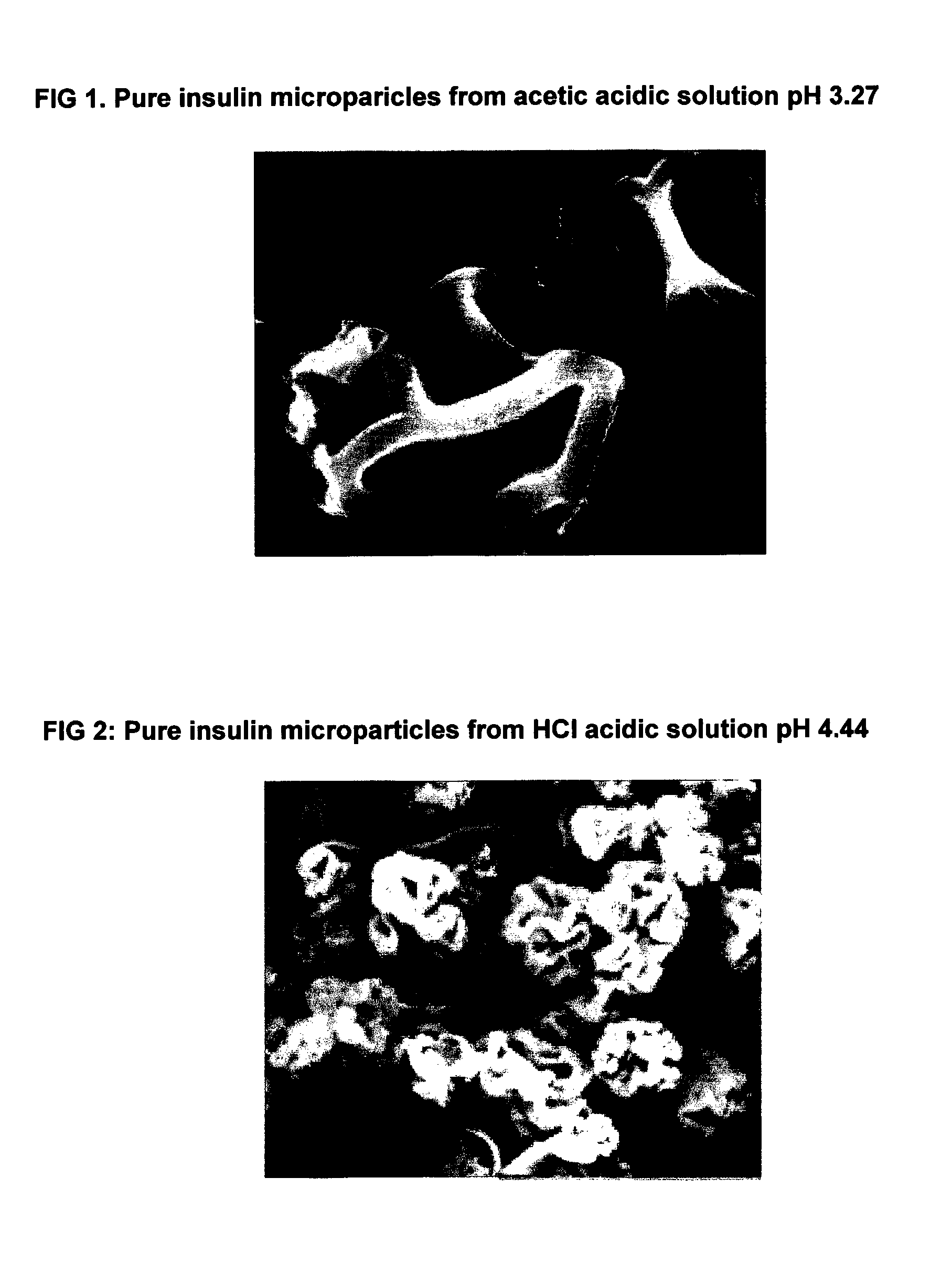Insulin highly respirable microparticles
a technology of respirable microparticles and insulin, which is applied in the direction of radiation therapy, animal/human protein, therapy, etc., can solve the problems of small surface area available for absorption, inability to deliver a drug to the alveolar region of the respiratory tract, and difficulty in achieving high respiration efficiency, low tapped density, and superior stability
- Summary
- Abstract
- Description
- Claims
- Application Information
AI Technical Summary
Benefits of technology
Problems solved by technology
Method used
Image
Examples
example 1
A) Formulation.
[0029]2550 mg of highly purified bovine insulin was dissolved in 200 ml of aqueous 10−2M hydrochloric acid. The solution was added with 100 ml of distilled water and then with 450 mg of mannitol under stirring to give a final solid concentration of 10 mg per ml (8.5 mg bovine insulin per ml). The pH of the clear solution was adjusted to 4.35 using NaOH 0.1 N dropwise.
B) Spray Drying.
[0030]This solution was filtered and was spray dried using a Mini spray drier Büchi, model 191 (Büchi, Labortechnik AG, Flawil, Switzerland) under the following process conditions: feed flow rate 195 ml / h; nozzle gas flow rate 600 nl / h; atomizing nozzle diameter 1.0 mm; inlet air temperature 120° C., producing an outlet temperature of 42° C.; aspirator capacity 100% setting. The yield was about 60%.
C) Characterization.
[0031]The collected powders were assayed by HPLC for covalent aggregation and degradation products (A21 desamido insulin) according to the European Pharmacopeia 4 (pag. 1368-...
example 2
A): Formulation.
[0033]975 mg of bovine insulin was dissolved in 95 ml of aqueous diluted acetic acid (pH 2.6). The solution was added with 0.6 ml of NaOH 1 M. The pH of the clear solution was 3.27.
B): Spray drying Process.
[0034]This solution was filtered and subsequently spray dried using a Mini spray drier Büchi, model 191 (Büchi, Labortechnik AG, Flawil, Switzerland) under the following process conditions: feed flow rate 200 ml / h; nozzle gas flow rate 500 nl / h; atomizing nozzle diameter 1.0 mm; inlet air temperature 130° C., producing an outlet temperature of 55° C.; aspirator capacity 100% setting. The yield was about 50%.
C) Characterization.
[0035]The collected powders were assayed by HPLC for covalent aggregation and degradation products (A21 desamido insulin) again according to the European Pharmacopeia and by the already quoted assays. The potency was 28.9 Ul / mg, the related proteins were 0.6% and the impurities with molecular mass greater than insulin was 0.33%. The particle ...
example 3
A) Formulation.
[0036]1750 mg of highly purified bovine insulin was dissolved in 120 ml of aqueous 10−2 M hydrochloric acid. The solution was added dropwise with0.0.7 ml of 1 N NaOH to give a final pH of about 4.44. The solution is clear and contains about 15 mg per ml of solids.
B) Spray Drying Process.
[0037]This solution was filtered and then spray dried using a Mini spray drier Büchi under the following process conditions: feed flow rate 195 ml / h; nozzle gas flow rate 600 nl / h; atomisng nozzle diameter 1.0 mm; inlet air temperature 120° C., producing an outlet temperature of 46° C.; aspirator capacity 100% setting. The yield was about 55%.
C) Characterization.
[0038]The microparticles were assayed by HPLC for covalent aggregation and degradation products (A21 desamido insulin) according to the European Pharmacopoeia, by SEM for morphology investigations, by laser diffraction for particle size distribution and by Andersen Cascade Impactor for respirable fraction evaluation.
[0039]The p...
PUM
| Property | Measurement | Unit |
|---|---|---|
| aerodynamic diameter | aaaaa | aaaaa |
| concentration | aaaaa | aaaaa |
| density | aaaaa | aaaaa |
Abstract
Description
Claims
Application Information
 Login to View More
Login to View More - R&D
- Intellectual Property
- Life Sciences
- Materials
- Tech Scout
- Unparalleled Data Quality
- Higher Quality Content
- 60% Fewer Hallucinations
Browse by: Latest US Patents, China's latest patents, Technical Efficacy Thesaurus, Application Domain, Technology Topic, Popular Technical Reports.
© 2025 PatSnap. All rights reserved.Legal|Privacy policy|Modern Slavery Act Transparency Statement|Sitemap|About US| Contact US: help@patsnap.com

